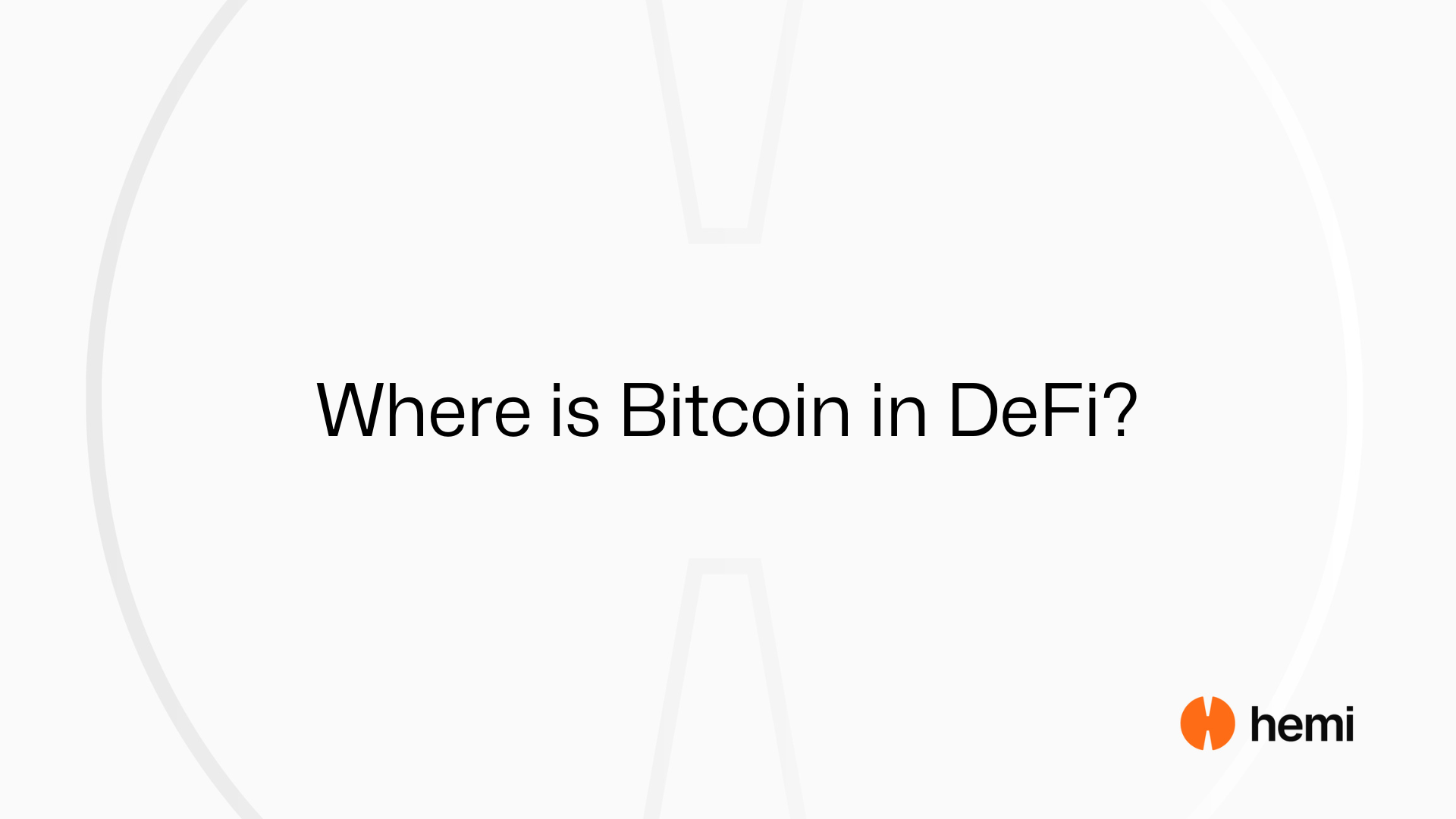- Bitcoin
- Ethereum
- Hemi
- Learn Center
- March 3, 2025
Where is Bitcoin in DeFi?
We explore what it means for Bitcoin to truly be part of the DeFi ecosystem.

TL;DR:
Bitcoin in DeFi still relies on centralized custodians, exposing users to security risks like minimal transparency, counterparty risk, and bridge vulnerabilities, with over $18 billion in wrapped Bitcoin controlled by entities like BitGo, Binance, and Coinbase. Hemi Tunnels offer a decentralized alternative, enabling Bitcoin to move into DeFi without intermediaries by using smart contracts and multi-signature vaults. With integrations like Stargate, Meson, and Free Tech, Hemi ensures trust-minimized cross-chain transfers. Its architecture, powered by the Hemi Virtual Machine (hVM) and Proof-of-Proof consensus, aligns with Bitcoin’s decentralized ethos, eliminating third-party reliance while securing transactions.
The DeFi ecosystem is built on principles of permissionless access, minimal trust, security, and seamless asset movement between users and marketplaces. However, Bitcoin—the most decentralized asset and a leading store of value—still relies on centralized custody models to enter DeFi. Why should that be the case?
Billions of dollars in Bitcoin are deployed across today’s DeFi marketplace, relying on intermediary custodians to hold the collateral behind wrapped assets. In fact, over $18 billion in Bitcoin is wrapped by centralized entities:
- WBTC has a market cap of $12.6 billion with custody from BitGo.
- BTCB has a market cap of $6.3 billion, with custody from Binance.
- cbBTC has a market cap of $2.2 billion, with custody from Coinbase.
These institutions add centralization and require users to trust them, introducing security risks that undermine the core principles of DeFi and ultimately affect users. These risks include:
- Lacking transparency: Many institutional exchanges that offer a wrapping function as black box systems without visibility into the real-time proof of reserves.
- Counterparty risks: Users rely on the custodian to ensure safety. If they are hacked, face regulatory intervention, or decide to freeze an account arbitrarily, users may lose access to their assets.
- Bridge vulnerabilities: Crosschain bridges today represent one of the largest vulnerabilities in DeFi, with hacks accounting for billions of dollars in losses, such as the Ronin Bridge, Multichain, and Binance Bridge exploits.
Hemi Tunnels Keep Bitcoin And DeFi Decentralized
Hemi Tunnels are an alternative to risk-laden bridging models, eliminating the need for trusted custodians and third-party control. Instead, Hemi introduces a secure, decentralized tunnel mechanism that allows Bitcoin, and other assets, to flow into DeFi markets without counterparty risks.
The tunnels feature a decentralized architecture where no single entity manages assets. Instead, Bitcoin and EVM-based assets move from origin chain to destination chain via smart contracts and multi-signature vaults.
Hemi offers a native tunnel as well as asset tunneling via:
- Stargate: an instant cross-chain solution built for real-time reliable liquidity.
- Meson – A stable swapping cross-chain asset transfer protocol optimized for minimal slippage.
- Free Tech – A Bitcoin cross-chain solution catering to participants who prioritize decentralization.
Centralized architectures have only scratched the surface of Bitcoin’s $950 billion market capitalization, exposing a small fraction of the potential Bitcoin can bring into DeFi, and wider activities. Hemi is a trust-minimized alternative for Bitcoin to flow into ecosystems unhindered by the systemic risks of bridges or central providers.
Hemi aligns with the decentralized architectures of Bitcoin in numerous ways, from its finality mechanism to its native tunnels for asset transfers. The Hemi Virtual Machine™ (hVM™) syncs Bitcoin and EVM-ecosystems, eliminating the need for third-party oracles and allowing seamless operation of live-state dApps.
All Hemi transactions reach an ultimate state of superfinality as the network anchors verified transaction data in blocks on the Bitcoin blockchain. This process is achieved through Hemi’s hybrid Proof-of-Proof consensus mechanism, which reinforces security and holds to the tenets of what Bitcoin was founded on.
These measures ensure that Bitcoin on Hemi remains the way it was meant to be: decentralized.